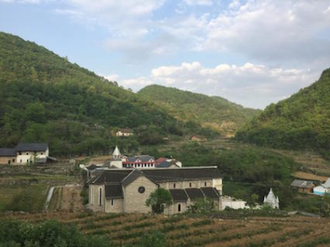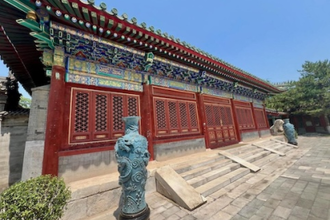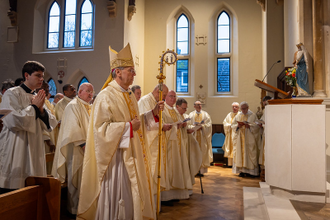China: A long-term view in the context of Faith

St Anthony's Church
The Covid-19 virus has subsided in China, and in Wuhan, where it started, restrictions are very slowly being lifted. A Catholic based in the city sends this exclusive report about venturing out of the city.
A narrow winding road through the mountains of western Hubei province leads to St Anthony's Church, an architectural treasure in the village of Shiguntang. As we travelled the scenic road last week we slowed down every few minutes to cautiously find a way around a mound of earth or stone that covered half the width of the road. For more than two months these obstacles had crossed the entire width of the road to prevent the flow of all traffic during the COVID-19 restrictions. The recent partial relaxation of restrictions in China has led to a similar partial removal of the obstacles.
This mountainous area of China must have seemed like a different world in 1892 when the Belgian Franciscans completed the construction of the fine church and monastery in an area where a Christian presence has existed since the 1750s. The ebb and flow of Chinese history has been lived out in this area as much as any other place in the country. Since about 70 years ago the structural quality of the church and monastery ensured their suitability to be preserved by the civil authorities and used as a school, a political centre and a warehouse. Thirty years ago the buildings were returned to the Church and have once again become an active centre of parish life.
When we arrived at the church, some surprise was expressed by the priest and sister who greeted us. The previous day our visit had been arranged with a person who had forgotten to pass on the news of our arrival. His absence when we arrived required a little bit of adjustment for the people as they prepared to sit down for evening meal. As so often happens in China, even in the midst of such a surprise, we were assured that all would be fine. A few minutes later we were told that accommodation was ready upstairs. Within half an hour we were sitting down to the evening meal with several others who were at the parish for various reasons.
Ten of the people who were sitting down for evening meal were local workmen, good-humoured volunteers from the Catholic community who were finishing another day of redeveloping the garden area and restoring the hillside gravestones of lay people whose contribution to the community's faith is still honoured.
In many areas of China, tracing the roots of Christian faith back to a particular family is a common part of the life of the Church. The influence of one clan permeates subsequent generations, a reality in which many people can proudly name their particular connection with the original custodians of the faith. Such claims are often made in humble settings where there is very little else that might immediately stand out for special attention, the historical links of faith being enough to strengthen poor people to stand tall to claim their special place as members of the Church.
The interior of the spacious St Anthony's Church reflects the simplicity of life for people in the parish. As is normal in many parts of China, the following morning saw Catholics beginning to assemble shortly after 6am to prepare for Mass. In the pews were a few memorial cards of the last bishop of Yichang diocese, Lu Shouwang, a popular shepherd of the people who died in 2011 less than four years after being appointed to the role by the Vatican. A kind and faithful servant, his death at the age of 45 was an experience of deep sadness for all who knew him. Even in the years since his passing, conversations with people at the church made it clear that the passage of time has deepened their appreciation for his life, his untimely death due to illness being yet another disruption in the unpredictable journey of faith that keeps unfolding.
Like many areas of rural China, the parish of Shiguntang was relatively unaffected by the coronavirus. Before restrictions were imposed, some people from the nearby city of Yichang moved to the parish, confinement in these spacious surroundings seen as a better option to being restricted in a city apartment for over two months.
Throughout the former monastery there are constant reminders of earlier times. Large limestone slabs overlap to form a solid staircase to the upper floor, each step having witnessed the full spectrum of Church history that has taken place over 128 years, much of that time filled with insecurity. The long corridor upstairs echoes a time when Franciscan missionary monks lived a life regulated by prayer times, aware that they would never return to their people in faraway Belgium. Their commitment so many years ago as they said goodbye to family and friends before setting out on a one-way journey to China must have stretched the heart and mind well beyond the point of consolation.
The missionaries who lived in this mountainous area of China over 100 years ago would hardly have expected that the area would eventually become a well-known place. This mountainous area of Hubei province provides a narrow channel for the Yangtze River to flow eastwards. Three distinct areas stretching over a vast distance of the river channel became known as the Three Gorges, towering slopes of rock that contain the massive quantities of water that initially begin as a trickle of snow melt in the distant Himalayan Mountains and are supplemented each summer by torrential summer rains in Sichuan and Hubei. The construction of a dam in the Three Gorges area was first proposed in political circles as far back as 1919. It featured a number of times in discussions in subsequent years until a final decision was made in 1992 by the National People's Congress. Construction began in 1994 and, following various milestones, it was declared fully operational in 2012, the water behind the dam wall measuring a huge 110 metres higher than the level of the river at the downstream side. Many questions remain about the long-term viability of the project. Supporters point to the merits of it being the biggest hydroelectric generating station in the world and providing increased flood protection in central China.
The interaction of the old and the new in this part of China happens at many levels. At the parish church, a substantial book written 100 years ago by the Franciscans contains several unique photographs, mainly relating to the parish of Shiguntang. The book, recently received from Belgium, is one of the community's treasures in its efforts to recover and preserve its history. The sacristy wall has several framed photographs of people who served the community over many years. As the parish seeks to build up a more complete record of its own history, the administrator of the diocese is hoping that Church archives in other countries may become a source of valuable material to fill the historical gaps that exist locally. A growing connection between the parish and the people of the province is taking place in a surprising development. The location of the church has made it a popular point of rest for cycling groups who see these quiet mountain roads as a good test of stamina, the beautiful church providing them with a suitable background for their group photographs, a setting that can lead to a point of initial contact for some of them with the Church.
Last week in this area of China the gradual relaxation of COVID-19 restrictions could be easily seen. A visit to a nearby Catholic family for lunch confirmed for us that social distancing has certainly been set aside, with everyone hoping that the change is permanent.
Leaving the parish in the afternoon, we descended slowly along the winding mountain roads, rock and tilled land visible in equal quantity. The partially removed earthen and stone barriers that we had seen on our arrival still covered half the road. A final instruction for their removal has not yet been issued. However, a gradual return to normal life is taking place here one step at a time. People in the parish of Shiguntang are grateful for a road that is partially open. In many countries around the world, as progress is made with virus containment, the same signs of hope would be a welcome development.
The Belgian Franciscans who patiently built a church and monastery in this mountainous part of Hubei province in the late 19th century were witnessing to an understanding of life that sees all people as members of one human family. Wherever we live and whatever the era, our hopes and daily concerns are usually very similar. The lessons of history can teach us that the challenges we face in one year can be tamed of their power if we see them against the background of a longer time in which the symbols around us point to God's enduring presence and protection over several generations.


















